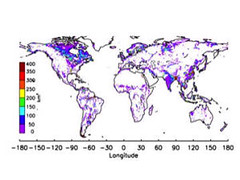ScienceDaily (May 11, 2012) — The area of the globe covered by wetlands (swamps, marshes, lakes, etc.) has dropped by 6% in fifteen years. This decline is particularly severe in tropical and subtropical regions, and in areas that have experienced the largest increase in recent decades.
These are the conclusions of a study conducted by CNRS and IRD researchers from the Laboratoire d'étude du rayonnement et de la matière en astrophysique (CNRS / Observatoire de Paris / UPMC / Université de Cergy-Pontoise / ENS), Laboratoire d'études en géophysique et océanographie spatiales (CNRS / IRD / CNES / Université Toulouse III-Paul Sabatier) and the start-up Estellus.* To obtain these results, the scientists performed the first worldwide mapping of the wetlands and their temporal dynamics, for the years 1993 to 2007.
This study, which has just been published in the journal Geophysical Research Letters, emphasizes the impact of population pressure on water cycles.
SMarshes, lagoons, swamps and bogs are all types of wetlands -- regions where water is the main controlling factor for the environment and its plant and animal life. Although they cover less than 5% of Earth's land surface, these areas play a key role in human activities, biodiversity, climate and the water cycle. Indeed, they produce one third of atmospheric methane, a major greenhouse gas. Moreover, these regions impact the transfer of continental freshwater to the sea and alter local weather by enhancing evaporation. More
